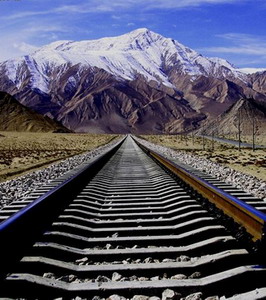Qinghai-Tibet Railway

-
Name:Qinghai-Tibet Railway
-
Route :Xining to Lhasa
-
Length :1956 km (1215 mile)
-
Overview:Construction of the 815 km (506 mi) section between Xining and Golmud was completed by 1984. The 1142 km (709 mi) section between Golmud and Lhasa was completed bywas completed on 12 October 2005.
The Qinghai–Tibet railway from Golmud to Lhasa was opened on July 1, 2006.
Overview
The total length is 1,956 kilometers long, with 960 km of the track located 4,000 meters above the sea level and the highest point at 5,072 meters. The project is dubbed an "engineering marvel" because people used to think the perennial ice and slush along the route could never support tracks and trains.
Construction of the 815 km (506 mi) section between Xining and Golmud was completed by 1984. The 1142 km (709 mi) section between Golmud and Lhasa was completed bywas completed on 12 October 2005.
From October 2006 five pairs of passenger trains run between Golmud and Lhasa, and one more pair between Xining and Golmud. The line has a capacity of eight pairs of passenger trains, and the carriages are specially built and have an oxygen supply for each passenger.
Oxygen Supply on the train
Oxygen dispensing facilities are available near seats and in passageways. Any passenger suffering from an adverse reaction to high altitude can ask for an oxygen inhaler that plugs in to the dispensing device by their seat.
In order to ensure sufficient power and oxygen supply, Qinghai-Tibet Railway trains are powered with three-engine, full steam diesel locomotives designed by GE.
Views along the railway
The line includes the Tanggula Pass, which, at 5,072 m (16,640 feet) above sea level, is the world's highest rail track.
The 1,338 m Fenghuoshan tunnel is the highest rail tunnel in the world at 4,905 m above sea level. The 4,010-m Guanjiao tunnel is the longest tunnel from Xining to Golmod and the 3,345-m Yangbajing tunnel is the longest tunnel from Golmod to Lhasa. More than 960 km, or over 80% of the Golmud-Lhasa section, is at an altitude of more than 4,000 m. There are 675 bridges, totalling 159.88 km, and about 550 km of the railway is laid on permafrost.
Passengers can enjoy the changing scenery from their train window in the comfort of a constant temperature. All the train windows are double-glazed and UV protective, and oxygen is available for any passengers that experience symptoms of altitude sickness.
The views are breathtaking. Clouds float in the vast azure sky over the plateau through which towering, snow-covered peaks may occasionally be glimpsed, before a clear blue lake suddenly springs into view. Wild donkeys race the train across seemingly boundless pastureland, occasionally keeping up, as they are capable of reaching 60 km per hour at a gallop. In contrast, the wild yak indigenous to the plateau strolls along at a calm, steady pace.
...more informations of scineries along the Qinghai-Tibet Railway
Facilities and service
All the trains to Lhasa, capital of Tibet Autonomous Region, are equipped with the most advanced technology. Carriages are installed with Canadian-made lightning insulation, an air filtering system, oxygen breathing devices, and air-conditioners that puff out oxygen when it is needed.
Other train facilities include built-in garbage containers, bright and spacious washrooms, and environment-friendly toilets that do not discharge waste on to the rails.
Each car also has a bathroom for the disabled. Wireless communication services along the Qinghai-Tibet Railway ensure that passengers have unrestricted access to information from around the world.
The dining car is decorated in typical Tibetan style and also provides box lunches and suppers for RMB 20, but the rice is not as tender as it would normally be owing to the low oxygen at high altitudes. Breakfast comprises gruel, buns and cold pickled vegetables.
....more details of facilities and service on the train
Local Passengers
Tibetan passengers usually bring along their own comestibles of dried beef and zanba (roasted barley flour, a staple of the Tibetans) that they have with a drink of hot water.
Many of them can only offord tickets for hard seats, especially for Tibetan students who go to universities in inner China province, and villagers searching for better personal careers at big cities in middle and east China.



